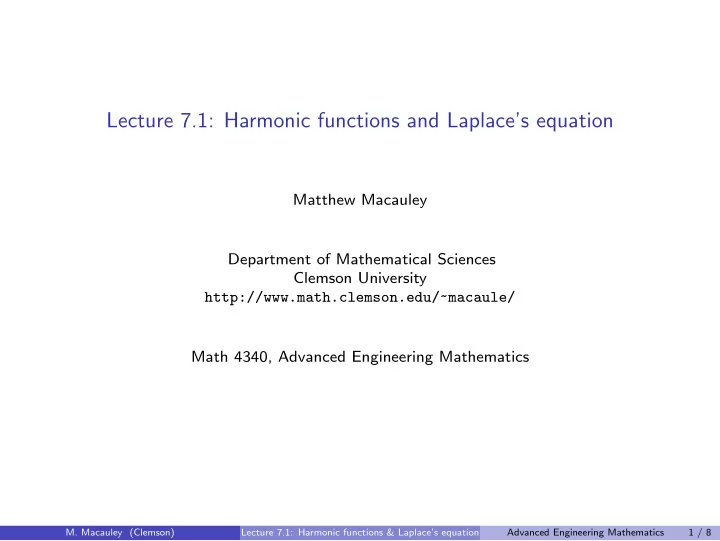

Lecture 7.1: Harmonic functions and Laplace’s equation Matthew Macauley Department of Mathematical Sciences Clemson University http://www.math.clemson.edu/~macaule/ Math 4340, Advanced Engineering Mathematics M. Macauley (Clemson) Lecture 7.1: Harmonic functions & Laplace’s equation Advanced Engineering Mathematics 1 / 8
Higher dimensional PDEs Recall the del operator ∇ from vector calculus: � ∂ ∆ := ∇ · ∇ = ∂ 2 + · · · + ∂ 2 ∂ � ∇ = , . . . , , . ∂ x 2 ∂ x 2 ∂ x 1 ∂ x n 1 n In R n Heat equation: u t = c 2 ∆ u Wave equation: u tt = c 2 ∆ u Remark Steady state solutions: occur for the heat equation ( heat dissipates ) do not occur for the wave equation ( waves propagate ) Definition A steady-state solution means u t = 0. Thus, all steady-state solutions satisfy u t = c 2 ∆ u = 0, i.e., ∂ 2 u + ∂ 2 u + · · · + ∂ 2 u ∆ u = 0 = ⇒ = 0 . ∂ x 2 ∂ x 2 ∂ x 2 1 2 n A function u is harmonic if ∆ u = 0. M. Macauley (Clemson) Lecture 7.1: Harmonic functions & Laplace’s equation Advanced Engineering Mathematics 2 / 8
Properties of harmonic functions Key properties The graphs of harmonic functions (∆ f = 0) are as flat as possible. If f is harmonic, then for any closed bounded region R , the function f achieves its minimum and maximum values on the boundary, ∂ R . M. Macauley (Clemson) Lecture 7.1: Harmonic functions & Laplace’s equation Advanced Engineering Mathematics 3 / 8
Examples of harmonic functions M. Macauley (Clemson) Lecture 7.1: Harmonic functions & Laplace’s equation Advanced Engineering Mathematics 4 / 8
Solving Laplace’s equation on a bounded domain Example 1a Solve the following BVP for Laplace’s equation: u xx + u yy = 0 , u (0 , y ) = u ( x , 0) = u ( π, y ) = 0 , u ( x , π ) = x ( π − x ) . M. Macauley (Clemson) Lecture 7.1: Harmonic functions & Laplace’s equation Advanced Engineering Mathematics 5 / 8
Solving Laplace’s equation on a bounded domain Example 1b Solve the following BVP for Laplace’s equation: u xx + u yy = 0 , u (0 , y ) = u ( x , 0) = u ( x , π ) = 0 , u ( π, y ) = y ( π − y ) . M. Macauley (Clemson) Lecture 7.1: Harmonic functions & Laplace’s equation Advanced Engineering Mathematics 6 / 8
Solving Laplace’s equation on a bounded domain Example 1c Solve the following BVP for Laplace’s equation: u xx + u yy = 0 , u (0 , y ) = u ( x , 0) = 0 , u ( x , π ) = x ( π − x ) , u ( π, y ) = y ( π − y ) . M. Macauley (Clemson) Lecture 7.1: Harmonic functions & Laplace’s equation Advanced Engineering Mathematics 7 / 8
Unbounded domains and Fourier transforms Example 2 Solve the following BVP for Laplace’s equation, where x ∈ R and y > 0, and the solution u is bounded as y → ∞ : u xx + u yy = 0 , u ( x , 0) = f ( x ) . M. Macauley (Clemson) Lecture 7.1: Harmonic functions & Laplace’s equation Advanced Engineering Mathematics 8 / 8
Recommend
More recommend